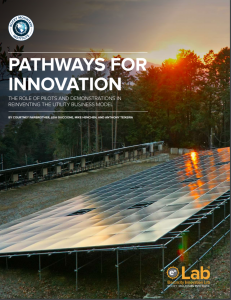Full Title: Pathways for Innovation
Author(s): Courtney Fairbrother, Leia Guccione, Mike Henchen, And Anthony Teixeira
Publisher(s): Rocky Mountain Institute
Publication Date: May 1, 2017
Full Text: Download Resource
Description (excerpt):
The rapid growth of distributed energy resources (DERs) and large-scale renewable energy is driving utilities to develop and test a wide range of new technologies, business models, and customer programs. These DERs are starting to impact the U.S. electric power system at significant scale—for instance, 2016 saw a record 2.5 GW of residential solar installation and 159,000 electric vehicles sold,1 up 19 percent and 37 percent, respectively, from 2015. Energy efficiency programs are lowering energy use at homes and businesses to the extent that many areas no longer see growing demand for electricity.
These changes pose new challenges for utilities. As energy efciency and self-generation erode customer electricity demand, utilities must determine how to fund needed investment in the grid with declining sales volumes. The proliferation of third-party energy devices on the grid creates new uncertainty for utilities in grid operation, as they move away from a traditional model in which the utility controlled all grid assets. In this era, utilities must develop new capabilities to integrate these new devices and manage two-way flows of energy on local distribution grids. Making the transition to a DER-rich future requires piloting new approaches to operating the electricity system, to engaging customers, to working with third-party DER providers, and to the utility business model itself.
We partnered with three leading utilities—Arizona Public Service (APS), Avista Utilities, and Con Edison— to explore best practices for utility innovation and the design, execution, and evaluation of utility pilot and demonstration projects. We interviewed industry stakeholders representing regulatory bodies, utilities, technology providers, and advocates to gather broad input on what works well, what does not, and how to improve.
At its best, the U.S. electricity industry can test a range of promising and innovative approaches to integrating new technology for the benefit of customers, utilities, and the environment. This can happen efciently, with little wasted efort and efective cross-industry learning; and collaboratively, with utilities and technology providers working together with aligned incentives to achieve shared outcomes.
At its worst, innovation can get bogged down by contentious disputes between utilities and technology providers, low-value pilots that produce little in the way of results, inefective pilots hampered by organizational disconnects and poor design, and redundant programs that fail to learn from results elsewhere in the industry.
